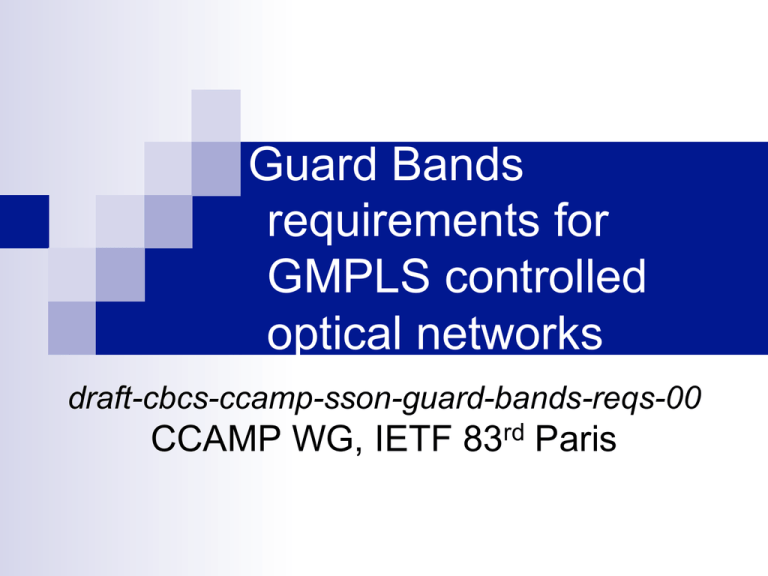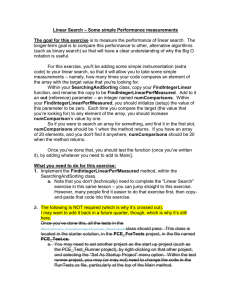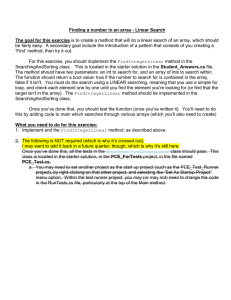Guard Bands requirements for GMPLS controlled optical networks
advertisement

Guard Bands requirements for GMPLS controlled optical networks draft-cbcs-ccamp-sson-guard-bands-reqs-00 CCAMP WG, IETF 83rd Paris Agenda n Goal and Definitions n Scenarios and Requirements n PCE – PCEP n Routing n Signaling n Open Issues n Next steps Goal and Definitions n n Goal: What is it addressing? "The draft gathers requirements for CP protocols to take into account Guard Bands when doing RSA Guard Band: is defined as the minimum frequency range which separates two contiguous signals, S1 at bit rate B1 and modulation format M1 and S2 at a bit rate B2 and modulation format M2, such that detrimental effects are negligible. Example of parameters impacting the GB: n n n Bit rate and modulation format of interfering signals Power values of signals at each span Fiber parameters (e.g. attenuation, dispersion, Kerr coefficient) Scenarios & Requirements n IV and RSA PCE : the PCE provides the ingress node with an impairment-validated route and a set of frequency slots. n n n n IV PCE: PCE provides ingress node with an impairment-validated route. Then, slot assignment is distributed n n n Stateful PCE: LSP-DB extended with info needed for GB computation (e.g. bit rate, mod format) Stateless PCE: TED extended with info needed for GB computation and hence routing protocol OSPF-TE extended for stateless PCE TED feeding PCE needs to inform the ingress node about GBs for the route, PCEP Path Computation Reply extended accordingly RSVP-TE extensions needed to identify the frequency spectrum along the path that should not be selected because of GB IV Candidate path PCE: PCE provides ingress node with a set of candidate routes (i.e., a set of impairment-validated routes). Then, a route is selected by the ingress node. n n PCE needs to inform the ingress node about GBs for the set of validated routes, PCEP Path Computation Reply extended accordingly RSVP-TE extensions needed to identify the frequency spectrum along the path that should not be selected because of GB Open Issues n ITU-T Q6/15 have not addressed guard bands in latest G.694.1 recommendation n Parameters for Guard Bands computation are not known yet (and may remain implementation dependent?) n Too early for encoding design n Guard bands implicit or explicit? Next steps n Liaison needed? n Need to ask Q6/15 what the plans for Guard Bands are? n It would be helpful the design SSON encoding so to be extensible for Guard Bands support n WG feedbacks collection GMPLS OSPF-TE Extensions in support of Flexible-Grid in DWDM Networks CCAMP WG, IETF 83rd, Paris, France draft-zhang-ccamp-flexible-grid-ospf-ext-01.txt Fatai Zhang (zhangfatai@huawei.com) Xian Zhang (zhang.xian@huawei.com) Ramon Casellas (ramon.casellas@cttc.es) O. Gonzalez de Dios (ogondio@tid.es) D. Ceccarelli (daniele.ceccarelli@ericsson.com) Changes from version 00 • Described various kinds of Labels Set – Inclusive/Exclusive Label Range – Inclusive/Exclusive Label Lists – Bitmap • Added port label restriction information Labels Set sub-TLV 193.1 THz … -9 -8 -7 -6 -5 -4 -3 -2 -1 0 6.25 GHz Inclusive Range : Start Label = 193.1 + (-2)*0.00625, End Label = 193.1 + (8)*0.00625 Bitmap: Base Label = 193.1 + (-1)*0.00625 Bitmap = (padded out to a full multiple of 32 bits) 1 2 3 4 5 6 7 8 9 ... DWDM link Available Frequency Inclusive Label Lists: Label 1 = 193.1 + (-2)*0.00625 Label 2 = 193.1 + (-1)*0.00625 Label 3 = 193.1 Label 4 = 193.1 + (1)*0.00625 … Label 10 = 193.1 + (7)*0.00625 Label 11 = 193.1 + (8)*0.00625 Port Label Constraints • G.694.1 says: – Applications may be defined where only a subset of the possible slot widths and positions are required to be supported. An example as follows: 193.1 THz … -8 -6 -4 -2 0 2 4 6 8 ... DWDM link Central frequency granularity = 12.5 GHz • Slot width granularity = 25 GHz The following parameters should be advertised (Port Label Restriction sub-TLV) – Central frequency granularity – Slot width granularity – Slot width range Discussion • Should slot width (or ‘m’) be advertised for the link resource (available spectrum)? – Slot width is only significant for a frequency slot (ie., a specific connection), There is no predefined fixed “wavelength” (i.e. slot width is not given before a frequency slot is allocated) therefore, no need to advertise slot width (or ‘m’) • What to do with unreserved bandwidth per prio, MAX LSP bw per prio in the ISCD? Next Steps the meeting or mailing list the meeting or mailing listprogress • Keeping alignment with ITU-T • Keeping alignment with ITU-T progress




